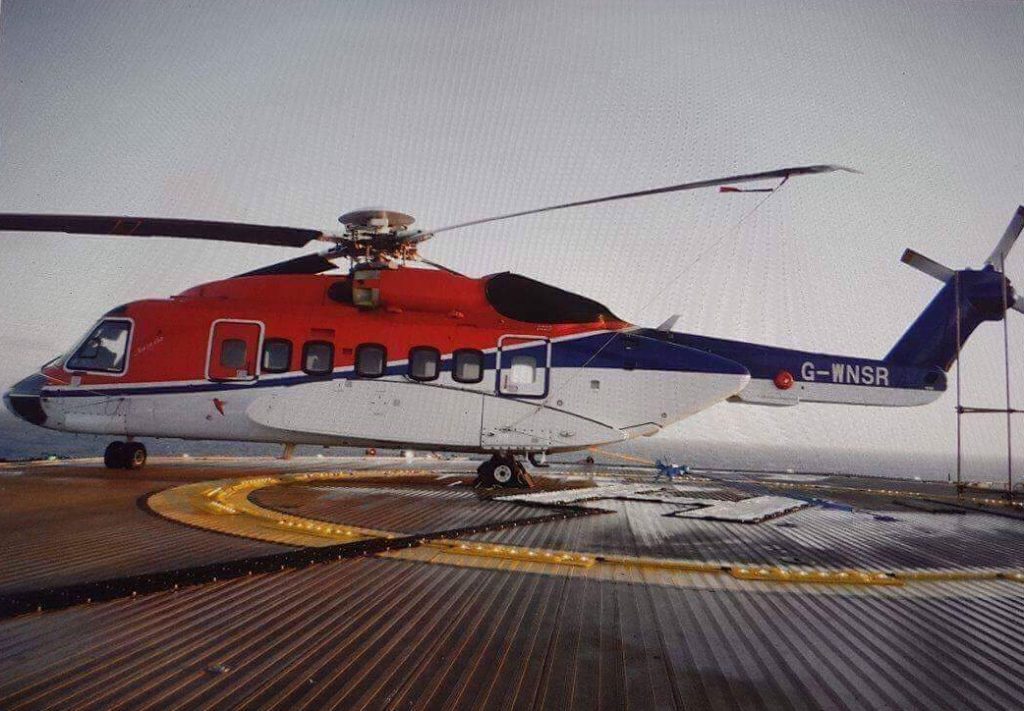
A North Sea flight spun 180 degrees unexpectedly as it attempted to land, investigators have found.
The Air Accidents Investigation Branch (AAIB) has published an interim report into a flight which got into technical difficulties last month.
The S-92 had been making a shuttle flight between the Elgin Process Utilities Quarters and the West Franklin platform when the incident occurred.
The report comes after the AAIB revealed on January 5th it would be sending a team to Aberdeen to investigate the flight.
The damage to the S-92 helicopter was described as being to the left outer mainwheel rim distortion, seized tail rotor putch change shaft bearing, servo piston fracture and minor damage to helideck.
The flight was the second sector of a four-sector rotation to the Elgin-Frankling offshore field in the North Sea.
In December, Energy Voice revealed “gouges” had been taken out of the helideck on the West Franklin platform as the flight got into technical difficulty on landing.
The helicopter was also understood to have “spun” on the installation after experiencing technical difficulties mid-air last week.
Pictures also emerged on social media in the aftermath of the incident which showed the parker aircraft as well as the damaged landing pad.
All nine passengers and two crew members on board when the incident took place were transferred safely to the platform.
CHC is also conducting its own investigation into the incident and said it was cooperating fully with the AAIB investigation.
The AAIB report said: “The helicopter commander was the handling pilot for both sectors. The first sector from Aberdeen to Elgin Process Utilities Quarters (PUQ) was uneventful. As the helicopter, on a heading of 270 degrees, with nine passengers on board, lifted from the Elgin PUQ helideck, it yawed unexpectedly to the right through 45 degrees.
“The commander applied full left yaw pedal, checked the rotation and landed back onto the deck. The flight crew discussed the likely cause, which they thought to have been the result of local turbulence or wind effects created by the platform structures which, anecdotally, is not uncommon for this helideck.
“The decided to continue and during the subsequent lift off into the hover the commander applied left yaw pedal, the helicopter responded and turned to the left; all control responses appeared normal.
“The commander then climbed to 500ft for the brief transit to the West Franklin wellhead platform, 3.3nm to the south.
“The helicopter made a normal approach and deceleration to the West Franklin and crossed over the helideck. During the descent to land, at approximately 4ft above the helideck, it yawed rapidly to the right, reaching a maximum rate of 30 degrees per second. At the same time it rolled 20 degrees to the left, at which point the left main landing gear contacted the helideck.
“It continued to yaw to the right on its left mainwheels and nosewheels before the right mainwheels contacted the surface.
“The helicopter came to rest on a head of 41 degrees having rotated through 187 degrees.”
The report comes just a day after Sikorsky recalled all S-92 helicopters globally for safety checks in the wake of the incident in December.
A spokesman for CHC said the operator welcomed the report from the AAIB.
He said:“CHC has worked closely with the AAIB and aircraft manufacturer Sikorsky. We will continue to support ongoing investigations by the AAIB and the NTSB, as well as Sikorsky into the root cause of the suspected TRPCS Bearing failure.
“We are confident that the measures we have taken and the actions directed by the Sikorsky in their ASB to all operators worldwide will continue to underpin the safety and airworthiness of the S92. The industry has acted swiftly to comply fully with the requirements of the ASB and to return the S92 to safe operations in both O&G and SAR roles worldwide, as soon as it was possible to do so.
“CHC’s top priority is the safety of everyone we carry in our aircraft. We have well established procedures and have been at the heart of developing industry guidelines for HUMS best practice. We will learn from any lessons to be drawn from this event and have already taken steps to further strengthen procedures and our compliance monitoring, as well as sharing this information with other operators.”
“The offshore helicopter industry has committed to sharing best practice and driving offshore transportation safety ever higher and will continue to do so through HeliOffshore.”
